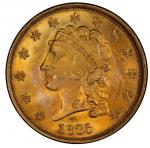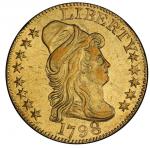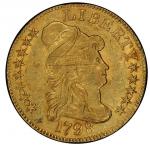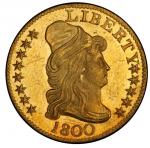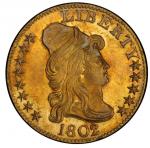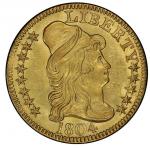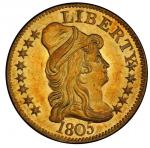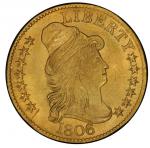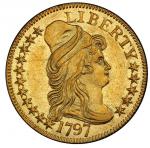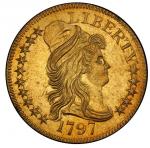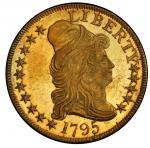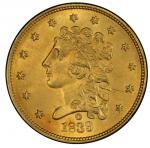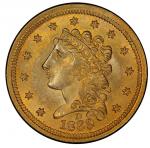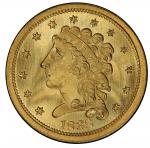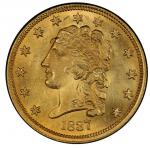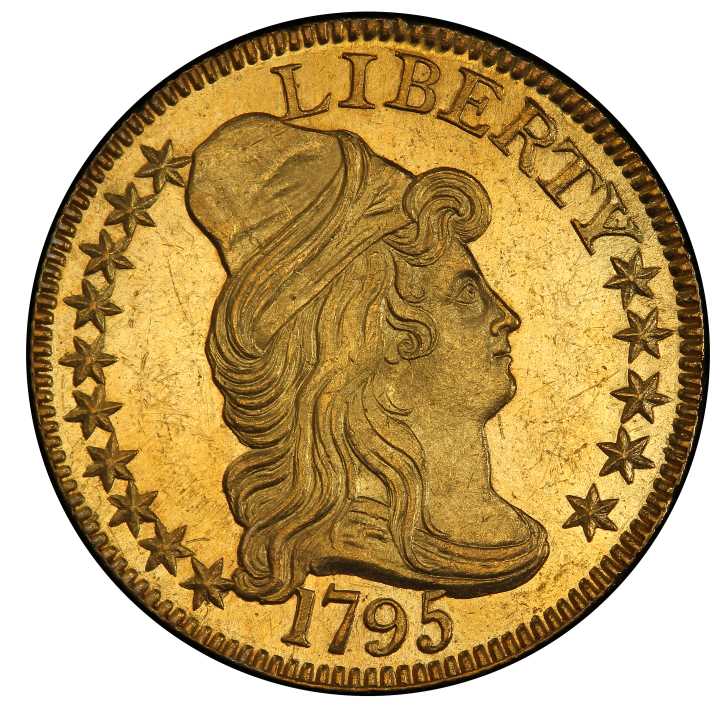1795 Capped Bust Right Half Eagle. Bass Dannreuther-15. Rarity-5+. Heraldic Eagle. Mint State-64 (PCGS).
"It is of course well known that the coins with the large or heraldic eagle are very rare." -- Thomas Ollive Mabbott,
"The Varieties of the Half Eagle of 1795," Numismatic Review, Stack's, July 1944
Nicely lustrous light yellow gold surfaces show both cartwheel and reflectivity, ringed in pale green-tinted gold at the peripheries. Very sharp, with trivial softness noted at the extreme centers of both sides. The process of turning over this 1795-dated coin and finding a Heraldic Eagle reverse is a discordant treat, revealing a reverse that is finely reflective in the fields but frosty over the design elements. Light hairlines are seen, along with a little jogging nick under TE of UNITED. A short apostrophe-shaped lintmark is present right of star 6, while another is horizontally oriented right of star 2. Genuine effort is required to see the extremely subtle adjustment marks oriented vertically in the soft spot at the obverse center; no others are noted.
The die state is advanced, equivalent to Bass-Dannreuther's obverse state b and reverse state c. A thin die crack begins at the rim above star 10 and zig-zags down the back of Liberty's cap and disappears into her hair. The reverse is spectacularly cracked at its base, with arcs radiating out from the rim like rings around a pebble in a pond. The largest arc crosses the eagle’s tail, barely touching the arrow butts on one side, crossing A and C before ending at the right top serif of I. Two other arc cracks stem from that one, beginning in the middle of the eagle’s tail, the lower one extending over the arrow shafts to the upper left serif of U and the rim, the upper one crossing the talon and traversing the left upright of N before connecting the tops of NITE. Other cracks extend across RI of AMERICA on a diagonal before stopping, mid-field, on the other side of the olive branch and travel from the base of C to the eagle's knuckle on its way to the shield. The reverse cracks were caused by an extremely bold die clash that has left the letters of LIBERTY impressed in that area, suggesting that the die became loose from the press and managed to forcefully impact the reverse die on an angle.
A numismatic exclave, disconnected from the 1795 Small Eagle half eagles by time and design, this variety was coined in either 1797 or 1798. Belying the date on the die, this obverse, along with two other 1795-dated obverses, was put back into use after the Heraldic Eagle reverse type debuted in 1797. While these distinctions are meaningful to collectors today, they likely meant little to the coiners then. With depositors expecting their gold quickly returned in the form of new United States coins, and government oversight encouraging efficiency and cost control, using a serviceable but out-of-date die was evidently preferable to creating a new die.
Though very rare as a major variety, three different die marriages of the 1795 Large Eagle or Heraldic Eagle half eagles exist. This die marriage is the most plentiful of them, though the Dannreuther-Bass book estimates that just 30 to 35 examples are known. The other two 1795 Large Eagle varieties share a reverse and both are extremely rare. BD-13 is known by just a single surviving specimen, while BD-14 has a population estimated at just 14 to 18 coins. The D. Brent Pogue coin is undoubtedly the finest known of this variety, finer than the specimen retained in the Bass Collection. The only other PCGS MS-64 of the 1795 Large Eagle type is the James A. Stack coin, struck from the more elusive BD-14 die marriage. It last sold in our January 2003 Rarities Sale, the only auction appearance of a PCGS-graded example certified finer than MS-62.
Illustrated as lot 1196 in our November 1955 Farish Baldenhofer sale, this coin was actually cataloged as lot 1195. Walter Breen points this out in his monograph Early United States Half Eagles 1795-1838, (originally published in 1965 as a series of articles in Numismatic Scrapbook Magazine), making note of "Baldenhofer 1195/96 (plates [were] transposed on these)." The other 1795 Large Eagle piece from the Baldenhofer sale is impounded in the Harry Bass Core Collection.





